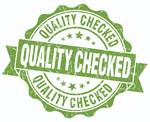
Most mold shops are well acquainted with the visible costs of poor quality. Still, these are just the tip of the iceberg compared to the deeper and more intractable invisible costs lurking below the waterline. Shops that think of quality as only a cost center enforce the incorrect perception that the quality function is essentially a thumbs up or the bearer of bad news. However, by embracing a comprehensive view of quality management, shops can limit the visible and hidden impacts of poor quality.
Calculating the True Cost of Quality
The true cost of quality is hard to quantify. The easy-to-see and easy-to-measure parts like inspection defects and internal failure rates are the elements that provide the metrics and data. Still, it is the less obvious costs that can have the most significant impact on quality.
To continue the iceberg analogy, the hidden costs below the waterline are the ones that drive up the cost of poor quality. These nested costs are a laundry list of failures that are the significant contributors to the cost of poor quality, such as engineering change orders, nonconformance, customer complaints, lost sales, late delivery, product re-works, supplier incapability, excessive raw material orders, long cycle times, working capital allocations, degraded brand image and lost customer loyalty.
Commonly referred to as the “hidden factory” by economists and quality professionals, these costs are more incremental and come into play when a drifting or “out of control” manufacturing process decreases both the quality and efficiency of production. In a perfect world with unlimited time, all defects would be identified, removed from production, fixed and placed back on the line. Unfortunately, we do not live in a perfect world.
One of the more defining characteristics of the hidden factory is that the longer problems exist, the higher the associated costs. There is a consensus that the cost of poor quality can be 10-15% of operations, and hidden costs can be as much as four times the visible costs. Noted quality guru Armand Feigenbaum believed that every American company had hidden factory operating costs that ranged from anywhere between 20-40% of total capacity.
If that is the case, then it is evident that the costs that lie beneath the surface are draining a significant amount of working capital. In a traditional manufacturing scenario—one in which a company has yet to automate its quality management process and relies on both the outdated image of quality as the “bad cop” and archaic working practices—nonconformances or other quality problems risk being lost in a series of disconnected systems.
It becomes clear that the cost of poor quality is less dependent on the visible costs and more related to the dangers that lurk beneath the surface.
As a result, corrective actions are delayed, if implemented at all, and the consequences beyond the obvious “above the waterline” issues are well hidden in the short-term. Over time, the “below the waterline” issues will have an even greater negative impact and require longer, more complex, and more costly fixes than had the issues been resolved in near real-time.
Recognizing Quality Bottlenecks
Tempting as it is to believe that the siloed approach to traditional defect handling is an anomaly in manufacturing, the fact is that this type of quality pain point happens regularly.
Expecting a corrective action ticket to be dealt with in seconds is unrealistic. Still, the failure to address the problem costs the company time, materials, money, and, ultimately, a loss of customer trust. Also, the quality management team is blamed for not responding quickly enough or overreacting, which leads to the rest of the company labeling them as a bad actor.
However, the quality function is typically not the problem. Instead, there is a need for the other business functions in the shop to recognize that the bottlenecks in the system have prevented the issue from being fixed in a reasonable timeframe and contributed to the less apparent costs of quality.
Quality is often disconnected from the rest of the shop, and there is still a perception that quality is a cost center instead of a business optimization or operational efficiency tool. When a problem occurs, the quality department often must take part in an internal game of “who did what,” spending its time chasing quality-related issues that are, by and large, preventable.
The overarching goal for any shop that wants to cement its reputation as a quality leader is to maintain not only a focus on continuous improvement but also a culture of quality throughout.
The relevant support from IT or management is often lacking, and full integration with other business processes is not always achievable, especially in shops that rely on paper-based processes and spreadsheets. Factor into the mix that business needs and customer demands are in constant flux. It becomes clear that the cost of poor quality is less dependent on the visible costs and more related to the dangers that lurk beneath the surface.
Effectively Implementing Quality Tools
So, how do we solve these demonstrated pain points? The obvious answer would be to increase investment in quality management systems that can identify and fix corrective action notifications with a minimum of fuss. However, that is only part of the solution.

Quality management needs to be done right from day one. The quality department is an integral part of the product lifecycle. These are also the people working on the quality frontline and are responsible for time-tested tools that drive reliability. As a result, the overarching goal for any shop that wants to cement its reputation as a quality leader is to maintain not only a focus on continuous improvement but also a culture of quality throughout.
Integrating a Plan-Do-Check-Act procedure should be a minimum requirement for any company that is serious about changing its attitude toward change. This integration must incorporate a complete corrective action process (including a purposeful problem statement), in-depth root cause analysis, an appropriately scoped action plan and an effectiveness check.
Also, quality leaders must manage change in a coordinated way. These actions include keeping procedures and work instructions up to date, ensuring ongoing compliance with workforce training requirements and defining the required scope and frequency for quality audits. All these pathways to continuous improvement are the basic platform on which a shop can solve seemingly complex quality problems.
Doing these things right will drive the quality culture across the organization and impact all the hidden issues and the more visible ones. As a bonus, it ensures that quality becomes everyone’s business—not just the “bad cops” that prevent products or projects from moving forward. Ultimately, a culture of quality must be instilled from the top down, and management must remove the notion that quality management is solely the bearer of bad news.
We live in a connected society where the fulfillment of customer expectations remains the benchmark for success, and quality plays a significant role in meeting these expectations. Quality has always mattered. What is important now is that decision-makers not only give it the recognition it deserves but also close the doors that lead to the hidden factory.
Related Content
Spotting Press Facilitates Safe, Productive Adjustment, Inspection and Repair of Molds
Millutensil highlights its specialization in mold and die spotting presses for mold validation, equipped to meet the needs of the operator when accessing or adjusting the mold.
Read MoreMold Solutions Target Safety, Storage and Productivity
NPE2024: Globeius and its suppliers showcase solutions focused on decreasing downtime, reducing energy consumption, increasing safety and more in an injection mold shop.
Read MoreIndustrial Drive Technologies Support Moving, Rotating Molds of All Sizes
RUD Tecdos solutions within its Mold Handling Solutions portfolio manage horizontal, vertical and rotational drive solutions for all environments.
Read MoreMold Racks Offer Safe, Practical Access and Storage Solutions
PCS Company’s Mold Storage Racks enable shop personnel to work safely and efficiently, while also providing support and protection for molds, dies and other equipment.
Read MoreRead Next
Top 10 Topics to Cover During an ISO 9001 Manufacturing Audit
Take a look at this practical hands-on approach to conducting a quality audit.
Read MoreA Practical Field Guide for ISO Best Practices
By focusing on existing people, processes and culture, ISO can help mold builders achieve dramatic improvements in sales, productivity, quality, service and profitability. Here is a practical field guide to ISO 9001.
Read MoreA Best-Practices Quality Strategy for Profitability
Guidelines for quality and business process improvement planning to help achieve true business performance improvement and return on investment.
Read More








.jpg;maxWidth=300;quality=90)






_300x250 4.png;maxWidth=300;quality=90)



.png;maxWidth=300;quality=90)










